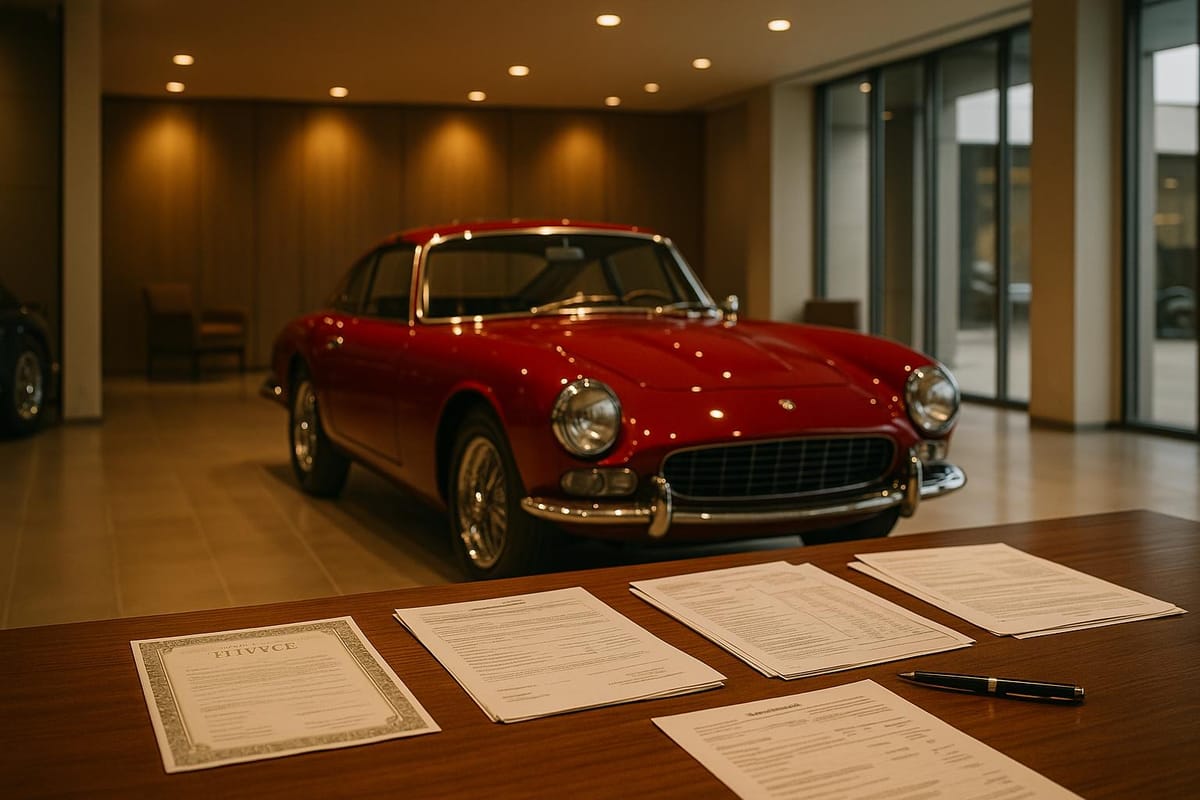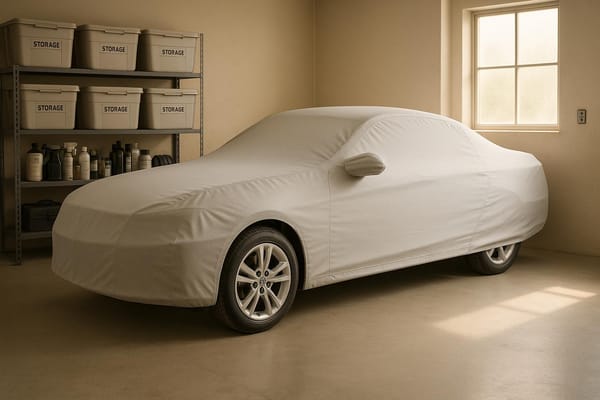Ultimate Guide to Liquidity Risk in Classic Cars
Learn how to navigate the unique liquidity risks of classic car investments, from market trends to documentation that enhances resale value.

Selling a classic car isn’t as simple as it sounds. Unlike stocks or property, classic cars face unique challenges when it comes to liquidity - the ability to sell quickly without a financial loss. Here’s what you need to know:
- Liquidity Risk: Classic cars can take months to sell, with discounts of 15–30% if sold under pressure.
- Costs Add Up: Storage, insurance, and maintenance during the sale process can cost £200–£500 per month.
- Market Timing Matters: UK sales peak in spring/summer, while winter sees a 30–40% drop in transactions.
- Buyer Preferences: Cars from the 1980s/1990s are increasingly popular with younger collectors.
- Documentation is Key: A complete service history and original features can significantly boost resale value.
Quick Overview of Key Metrics:
| Metric | Typical Range |
|---|---|
| Forced Sale Discount | 15–30% |
| Average Sale Period | 3–6 months for popular models |
| Storage Costs | £200–£500/month |
| Auction Success Rate | Healthy above 80%; constrained below 60% |
To minimise risks, diversify your collection, maintain thorough records, and plan for costs. Platforms like MARQHAUS can also help connect you with serious buyers, reducing sale times. Classic car investments aren’t quick flips - they require patience, timing, and strategy.
Market Factors Affecting Classic Car Liquidity
Buyer Patterns and Market Size
In the UK, the liquidity of classic cars often depends on a niche market of affluent and selective collectors. The preferences of these buyers play a pivotal role in determining how quickly a car sells. For instance, younger collectors are increasingly drawn to models from the 1980s and 1990s, making these vehicles easier to sell.
Economic conditions also weigh heavily on the market. During periods of economic uncertainty, buyer activity tends to slow, which can lengthen the time it takes to sell a car. On the other hand, when the economy is strong or alternative investments are underperforming, demand for classic cars rises, leading to faster sales.
Beyond buyer trends, factors like a car's rarity and its documented history significantly influence how quickly it can be sold.
Car Scarcity and History
Production numbers and a car's documented history are vital in shaping its liquidity. While extremely rare vehicles can command higher prices, their exclusivity may also narrow the pool of potential buyers. Cars that strike a balance between being exclusive yet not overly scarce tend to sell more easily.
A well-documented history can make a car far more appealing. Service records, ownership lineage, and original features all contribute to its desirability. Conversely, vehicles without proper documentation or with unclear histories often struggle to attract buyers. In such cases, sellers may need to lower prices because collectors place a high value on verified originality.
Several factors can enhance a car's marketability:
- Complete Service History: Detailed maintenance records can reassure potential buyers about the car's condition.
- Original Features: Cars that retain their factory specifications are often more desirable.
- Competition History: A proven racing pedigree can add significant appeal for enthusiasts.
Sales Platforms and Access
The way classic cars are sold has evolved, with traditional auction houses now competing with digital platforms. Online platforms like MARQHAUS provide curated listings and connect sellers with qualified buyers worldwide, offering greater market exposure and efficient price discovery.
Digital sales channels often facilitate quicker transactions by reaching a broader audience. In contrast, traditional methods, such as in-person auctions, may involve smaller markets and longer selling periods.
Measuring Liquidity Risk
Key Performance Indicators
To understand liquidity risk, keeping an eye on key performance indicators is crucial. One of the primary metrics is the auction success rate, which shows the percentage of vehicles that sell successfully at auction. A rate above 80% signals healthy market liquidity, while rates dipping below 60% point to significant constraints in the market.
Another important measure is time-to-sale, which reflects how quickly vehicles sell. For premium marques like Ferrari and Porsche, liquidity timeframes in strong markets usually range from 3 to 6 months. In contrast, more niche vehicles might take anywhere from 12 to 24 months to secure a buyer. These timelines often stretch further for cars needing restoration or those with incomplete documentation.
The bid–ask spread - the gap between what sellers expect and what buyers are willing to pay - widens significantly during periods of market uncertainty. For less liquid models, this spread can exceed 20–30%. Monitoring this metric gives insight into market sentiment and potential selling difficulties. Together, these indicators form the foundation for advanced price analysis techniques discussed below.
Price Analysis Methods
Because classic cars trade infrequently, their valuation requires specialised methods. Determining fair market value involves more than basic comparisons, as these vehicles often come with unique factors influencing their worth.
Some of the most effective price analysis techniques include:
| Analysis Type | Key Components | Impact on Liquidity |
|---|---|---|
| Condition Assessment | Standardised grading systems | Directly influences how quickly a car sells |
| Provenance Analysis | Ownership history, documentation, competition records | Can cause a 15–30% price difference between retail and private sales |
| Market Comparison | Recent sales of comparable vehicles, adjusted for condition | Impacts price discovery and transaction timing |
To reduce information gaps, investors should maintain thorough condition reports and ensure all documentation is in order. Vehicles lacking proper authentication can take 50–100% longer to sell and often face steeper discounts.
Market sentiment indicators are also valuable for predicting liquidity shifts before they appear in transaction data. Key metrics to monitor include:
- Dealer inventory levels and how long cars stay on the market
- Auction pre-sale registration numbers
- Sentiment in specialist media coverage
- Online search trends for specific models
Classic Cars: Passion or Profit? The Harsh Truth About Collecting vs Investing
Risk Management Methods
With market trends and liquidity challenges in mind, these methods offer practical strategies to help investors manage risks effectively.
Portfolio Balance
Spread your investments across different eras, marques, and price ranges to minimise liquidity risks. A mix of established classics and modern, investment-grade vehicles can provide both long-term stability and quicker access to funds when needed. This balanced approach helps you stay resilient through market ups and downs.
Cost Planning
Being prepared for downturns starts with smart cost planning. Keep a reserve fund that covers 12–24 months of expenses to avoid selling assets under pressure at poor prices. Budget for both fixed costs - like insurance, climate-controlled storage, maintenance, and registration - and variable expenses, such as restorations, sourcing parts, transport, and pre-sale preparations.
Market slowdowns can extend the time it takes to sell assets, so it’s wise to plan for such delays. Detailed maintenance records and condition reports can also support better resale values when the time comes.
Market Access Tools
While budgeting prepares you financially, having efficient access to buyers is just as important. Broad market access can significantly reduce liquidity risks. Platforms like MARQHAUS connect investors with high-quality investment vehicles and rare classics, simplifying the buying and selling process. This network of serious collectors can be a lifeline during challenging market conditions.
To maximise your market access, focus on these areas:
- Documentation Management: Keep all service histories, original documentation, and provenance intact. Maintain detailed restoration and maintenance records to enhance asset value and buyer confidence.
- Market Intelligence: Stay informed by monitoring auction clearance rates, tracking demand for specific models, and analysing price trends across various segments. Understanding market sentiment can help you make better decisions.
Key Takeaways
Here's a summary of the main points from our discussion on managing liquidity risk in classic car investments:
Understanding Market Dynamics: Classic cars are not quick-turnaround investments. They often require long holding periods, and selling can take even longer during market slumps.
Preserving Value: To keep demand high, ensure the car retains its original features and maintain thorough documentation.
Planning for Costs: Fixed and variable costs can add up quickly. Having sufficient reserves can prevent the need to sell during unfavourable market conditions.
Selling Channels: Traditional auction houses remain a go-to option for connecting with serious collectors, though they charge steep fees (typically 10–15%). However, platforms like MARQHAUS offer a modern alternative, expanding market access and simplifying transactions.
Portfolio Role: Classic cars can diversify an investment portfolio due to their low correlation with traditional assets. Experts recommend allocating only 5–15% of your portfolio to these assets to balance liquidity concerns.
Timing Matters: In the UK, market activity peaks in spring and summer, especially around events like the Goodwood Festival of Speed. Timing your sale during these periods can lead to better results.
These insights highlight the importance of strategic planning and market awareness for building a robust classic car investment portfolio. By following these principles, investors can navigate the challenges of this unique market with greater confidence.
FAQs
What steps can I take to minimise liquidity risk when investing in classic cars?
Minimising liquidity risk in classic car investments takes thoughtful planning and thorough research. Focus on vehicles with strong market demand and a track record of holding their value over time - these are the ones more likely to sell quickly if the need arises. Factors like rarity, condition, and provenance play a huge role in making a classic car appealing to potential buyers.
To spread the risk, consider diversifying your collection. Include cars from various brands, time periods, or styles, so you're not overly reliant on a single market segment. Staying up to date with market trends and seeking advice from industry professionals can also guide you towards smarter investment decisions. Platforms such as MARQHAUS offer a curated selection of rare, investment-grade vehicles, making it easier to identify high-quality options for your portfolio.
What factors affect how quickly a classic car can be sold?
The time it takes to sell a classic car hinges on a few important factors. Market demand is a major player - highly sought-after or rare models often find buyers quickly, while more niche vehicles might sit longer as they wait for the right enthusiast. Another big factor? Pricing. Setting a fair, market-aligned price can make a world of difference in how fast the car sells.
Beyond that, the car’s condition, its provenance (such as ownership history and supporting documentation), and the sales platform you choose all come into play. Presenting the car well - with high-quality photos, a detailed description, and a focus on its standout features - can draw more attention and speed up the process. Paying attention to these elements can make selling smoother and more effective.
Why is it important to keep detailed documentation when selling a classic car?
Maintaining detailed records is key when it comes to protecting and potentially increasing the resale value of a classic car. Documents like service records, restoration details, ownership history, and original purchase papers offer buyers reassurance about the car's authenticity and overall condition.
Potential buyers are often keen to see proof of proper upkeep and evidence that the car either remains original or has been restored to an excellent standard. Having thorough documentation not only builds trust but can also support a higher asking price, helping your classic car stand out in a competitive market.




